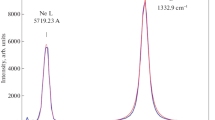Abstract
The residual polarization of negative muons in crystal silicon samples with phosphorus (P: 1.6×1013 cm−3) and antimony (Sb: 2×1018 cm−3) impurities is investigated. The measurements are made in a 1000 G magnetic field oriented in a direction transverse to the muon spin in the temperature range 4–300 K. The relaxation rate and shift of the precession frequency in the silicon sample with the phosphorus impurity are measured more accurately than previously. It is found that in antimony-doped silicon the acceptor center µ A1 at temperatures below 30 K can be in both ionized and neutral states. The experimental data are interpreted on the basis of spin-lattice relaxation of the magnetic moment of an acceptor center, formation of acceptor-donor pairs, and recombination of charge carriers at the acceptor. Preliminary measurements showed a nonzero residual polarization of negative muons in germanium.
Similar content being viewed by others
References
T. N. Mamedov, V. N. Duginov, V. G. Grebinnik et al., Hyperfine Interact. 86, 717 (1994).
W. Beez, T. Grund, M. Hampele et al., PSI Newsletter, Annex I, 125 (1993).
T. N. Mamedov, I. L. Chaplygin, V. N. Duginov et al., Hyperfine Interact. 105, 345 (1997).
G. Feher, J. C. Hensel, and E. A. Gere, Phys. Rev. Lett. 5, 309 (1960).
G. W. Ludwig and H. H. Woodbury, Bull. Am. Phys. Soc. 6, 118 (1961).
T. Shimizu and N. Tanaka, Phys. Lett. A 45, 5 (1973).
H. Neubrand, Phys. Status Solidi B 86, 209 (1978).
Th. Stammler, R. Abela, Th. Grund et al., Phys. Status Solidi A 137, 381 (1993).
R. Scheuermann, J. Schmidl, A. Seeger et al., Hyperfine Interact. 106, 295 (1997).
T. Suzuki, D. F. Measday, and J. P. Roalsvig, Phys. Rev. C 35, 2212 (1987).
M. Koch, K. Maier, J. Major et al., Hyperfine Interact. 65, 1039 (1990).
T. Shimizu and M. Nakayama, J. Phys. Soc. Jpn. 19, 930 (1964).
Y. Yafet, J. Phys. Chem. Solids 26, 647 (1965).
V. N. Gorelkin and D. V. Rubtsov, Hyperfine Interact. 105, 315 (1997).
Author information
Authors and Affiliations
Additional information
Pis’ma Zh. Éksp. Teor. Fiz. 68, No. 1, 61–66 (10 July 1998)
Rights and permissions
About this article
Cite this article
Mamedov, T.N., Duginov, V.N., Stoykov, A.V. et al. Investigation of acceptor centers in semiconductors with the diamond crystal structure by the μ − SR method. Jetp Lett. 68, 64–70 (1998). https://doi.org/10.1134/1.567822
Received:
Issue Date:
DOI: https://doi.org/10.1134/1.567822




